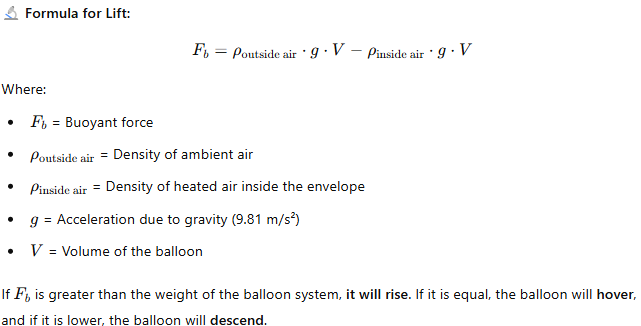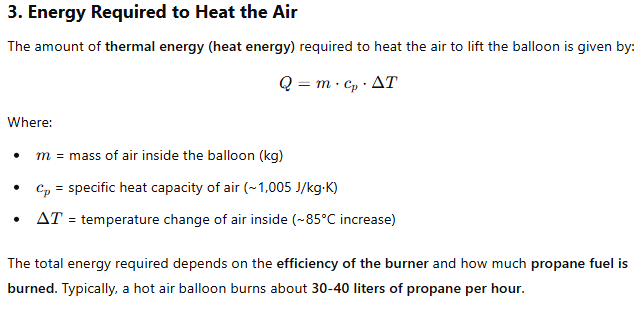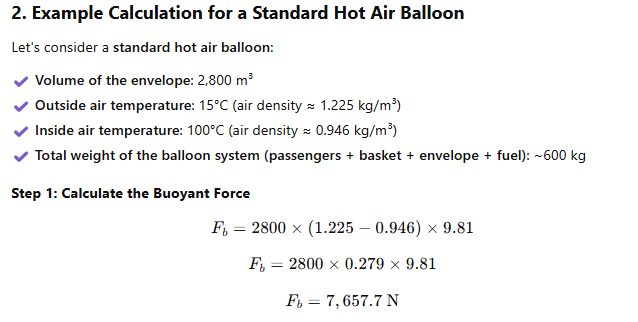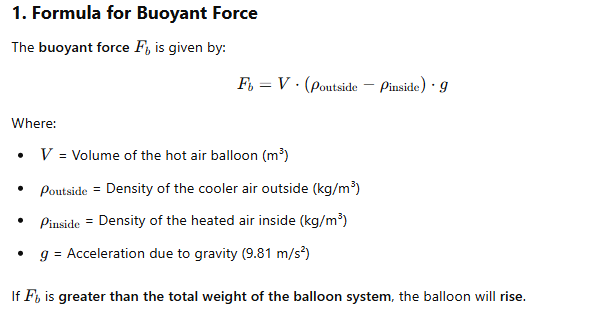Hot air balloons are one of the oldest and simplest forms of flight, yet they operate based on sophisticated principles of thermodynamics, buoyancy, and aerodynamics. This guide will break down how hot air balloons work, their technical components, physics of flight, and the science behind their maneuverability.
1. The Basic Principle: Buoyancy and the Role of Hot Air
Hot air balloons operate based on Archimedes’ Principle, which states that an object in a fluid (including air) will experience an upward buoyant force equal to the weight of the fluid it displaces.

How This Applies to Hot Air Balloons:
- Hot air is less dense than cold air.
- Heating the air inside the balloon reduces its density, making it lighter than the surrounding cooler air.
- This creates buoyant lift, causing the balloon to rise.





Buoyancy and Energy Requirements for a Smaller Hot Air Balloon
For a smaller hot air balloon with a volume of 1,000 m³, the calculations are as follows:
- Buoyant Force Generated: 2,737 N
- Required Lift Force (Gravity on Balloon System): 2,452 N
- Energy Required to Heat the Air: 104.65 MJ (Megajoules)
Key Takeaways:
✔ This smaller balloon is sufficient to lift about 250 kg (including the basket, burner, and a single passenger).
✔ It requires about 105 MJ of thermal energy to heat the air from 15°C to 100°C, which is less than half the energy needed for a standard balloon (2,800 m³).
✔ This size is typically used for solo flights or lightweight observation balloons.
2. Key Components of a Hot Air Balloon
1. Envelope (Balloon)
✔ The envelope is the large fabric part that holds the heated air.
✔ Made from nylon or polyester, coated with heat-resistant polyurethane.
✔ The top of the envelope has a vent (parachute valve) that allows hot air to escape for controlled descent.
✔ Typical volume: 70,000 to 250,000 cubic feet of air.
2. Burner System
✔ Produces an open flame to heat the air inside the envelope.
✔ Uses liquid propane, which is stored in fuel tanks in the basket.
✔ The pilot controls the flame intensity to regulate altitude.
Burner operation steps:
- Propane fuel is released from tanks under pressure.
- It is mixed with air and ignited by an electric spark or pilot light.
- The resulting flame reaches temperatures of 1,200°F (650°C).
3. Basket (Gondola)
✔ Holds passengers, fuel tanks, and the pilot.
✔ Made from woven wicker, which is lightweight and absorbs landing impacts.
4. Parachute Valve (Deflation System)
✔ A circular vent at the top of the envelope that can be opened to release hot air, allowing the balloon to descend.
3. Flight Mechanics of a Hot Air Balloon
1. How Does a Balloon Take Off?
- The burners heat the air inside the envelope.
- The air inside the envelope becomes less dense than the surrounding air.
- The buoyant force lifts the balloon off the ground.
💡 Fact: To lift a 1,000 kg (2,200 lbs) balloon, you need to heat about 80,000 cubic feet of air to around 100-120°C (212-248°F).
2. How Does a Balloon Stay in the Air?
✔ The pilot modulates the burner to maintain altitude.
✔ The balloon remains neutral (hovering) if the air temperature inside matches the needed buoyant force.
3. How Does a Balloon Descend?
✔ The parachute valve at the top of the envelope is opened to release hot air.
✔ As the air cools, it becomes denser, reducing lift.
✔ Gravity takes over, causing the balloon to descend gradually.
💡 Fact: A standard descent rate is 200-500 feet per minute.
4. How Does a Balloon Steer?
✔ Hot air balloons cannot be steered like airplanes; they rely on wind currents at different altitudes.
✔ Pilots change altitude to find wind currents moving in the desired direction.
🔄 Wind Layers Strategy:
- Lower altitudes might have winds moving westward.
- Higher altitudes might have winds moving eastward.
- Pilots ascend or descend to catch different wind layers and adjust the balloon’s course.
💡 Fact: Some advanced balloons use rotating vents to create a slow turning effect for minor directional adjustments.
4. Fuel Efficiency & Operating Conditions
Fuel Consumption
✔ Propane Usage: A typical balloon consumes 30-40 liters (8-10 gallons) per hour per burner.
✔ Flight Duration: Most balloons fly for 45 minutes to 1.5 hours per propane tank.
Weather Requirements
✔ Wind Speed: Safe conditions require winds below 10 knots (18 km/h, 11 mph) at launch.
✔ Temperature Considerations:
- Cold air increases lift efficiency.
- Hot and humid conditions require more fuel to generate lift.
💡 Fact: Balloon flights are almost always scheduled at sunrise, when the air is coolest and winds are calmest.
5. Safety Considerations in Ballooning
✔ Pre-Flight Checks:
- Inspect the envelope fabric for tears.
- Check burners and propane tanks for leaks.
- Confirm wind speeds and visibility conditions.
✔ Emergency Procedures:
- If the burner fails, the pilot makes a controlled descent using vents.
- In case of high winds at landing, passengers adopt a landing brace position.
- Fire extinguishers are always on board in case of a propane leak.
💡 Fact: Modern hot air balloons have redundant burner systems to ensure safety.
6. Modern Advances in Hot Air Balloon Technology
1. Smart Flight Instruments
✔ Modern balloons are equipped with GPS tracking, altimeters, and wind speed indicators for safer navigation.
2. Hybrid Balloons
✔ Some modern balloons integrate helium cells alongside heated air for extended flight duration.
3. Electric and Eco-Friendly Burners
✔ Advancements in electric burners and hybrid propane systems are reducing emissions in ballooning.
💡 Fact: EcoBalloons are being developed to run on hydrogen and solar power, making ballooning more sustainable.
Is a Hot Air Balloon Safe?
Yes! Hot air balloons are one of the safest ways to fly because they move slowly and rely on natural forces rather than engines.
Safety Features
✔ Backup burners in case one fails.
✔ Wind speed checks before takeoff.
✔ Trained and licensed pilots.
📌 Think of it like a safari vehicle—it won’t move fast like a plane, but it gets you where you need to go safely.
How Does a Hot Air Balloon Take Off?
Hot air balloons don’t just fly up instantly—there’s a process:
Step 1: Laying Out the Balloon
Before sunrise, the balloon is spread out on the ground near the launch site.
📌 Think of rolling out a giant Maasai shuka (traditional cloth) before wearing it.
Step 2: Blowing Cold Air Inside
A big fan blows cold air into the balloon to help it expand.
📌 Think of inflating a bouncy castle at a festival—same process, just much bigger!
Step 3: Heating the Air
The pilot turns on the burner, sending flames into the balloon. The hot air lifts the balloon upright.
📌 Think of a kettle on a fire—the hotter the steam, the more it pushes upwards.
Step 4: Lift-Off!
Once there’s enough hot air inside, the balloon becomes lighter than the air outside, and it lifts off the ground, carrying you into the sky!
📌 It’s like watching an eagle take flight—slow and graceful at first, then soaring high!
How Do Pilots Steer a Hot Air Balloon?
🚀 Unlike planes or cars, hot air balloons have no steering wheel! So how do pilots control where the balloon goes?
The answer: Wind currents!
1️⃣ Going Up or Down
✔ The pilot controls altitude (height) by adding or releasing heat.
✔ More heat = balloon rises.
✔ Less heat = balloon sinks slowly.
📌 Think of a bird flapping its wings (going up) and gliding down (going down).
2️⃣ Changing Direction
✔ Different wind layers blow in different directions.
✔ Pilots go up or down to find a wind current going in the right direction.
📌 Think of leaves floating on a river—some get carried left, some right, depending on the current.
💡 Fun Fact: Pilots often send up small test balloons before takeoff to see which way the wind is blowing!
5. How Does a Hot Air Balloon Land?
Landing a balloon is very smooth when done correctly:
1️⃣ The pilot slowly lets hot air escape from the vent at the top of the balloon.
2️⃣ As the air cools, the balloon gradually descends.
3️⃣ The basket touches the ground gently (sometimes with a small bump).
4️⃣ The crew catches the basket and helps secure it.
📌 Think of jumping off a camel—slow and steady to avoid a rough landing!
💡 Fun Fact: Many balloon safaris include a celebratory champagne breakfast after landing—a tradition dating back to the first hot air balloon flight in 1783!
Final Thoughts: Why Understanding Hot Air Balloon Physics Matters
A hot air balloon is more than just a beautiful spectacle; it is a marvel of physics and engineering. By leveraging the simple principle of buoyancy, combined with precise fuel control and wind navigation, pilots can create a smooth and controlled flight experience.
🌍 Next time you see a hot air balloon floating gracefully in the sky, you’ll know exactly how it works!
FAQs on How Hot Air Balloons Work
1. How does a hot air balloon rise into the sky?
Hot air balloons rise because hot air is lighter than cold air. The burner heats the air inside the balloon, reducing its density compared to the surrounding cooler air. This creates buoyancy, allowing the balloon to lift off the ground.
2. What are the main parts of a hot air balloon?
A hot air balloon consists of three main components:
- Envelope – The large fabric balloon that holds the heated air.
- Burner System – Produces the flame that heats the air inside the envelope.
- Basket (Gondola) – Where the passengers and pilot stand, and where the fuel tanks are stored.
3. How does a hot air balloon steer?
Hot air balloons do not have a steering wheel. Instead, pilots control movement by adjusting altitude to catch different wind currents.
✔ Higher altitudes may have winds blowing in one direction, while lower altitudes may have winds going in another.
✔ Pilots ascend or descend to find a wind current going in the desired direction.
4. How does a hot air balloon land?
To land, the pilot gradually releases hot air by opening a parachute vent at the top of the envelope. As the air cools, it becomes denser, and the balloon slowly descends.
✔ The pilot ensures a controlled landing by choosing a safe, open area.
✔ In windy conditions, the basket may tip slightly or drag a short distance before stopping.
5. How high can a hot air balloon go?
Most passenger hot air balloons fly between 500 to 3,000 feet (150 to 900 meters) for the best views. However, some experimental flights have reached altitudes of over 21,000 meters (68,000 feet)!
6. How long does a hot air balloon ride last?
A typical flight lasts 45 minutes to 1.5 hours, depending on weather conditions, fuel supply, and landing areas.
7. What fuel does a hot air balloon use?
Hot air balloons use liquid propane gas, stored in tanks inside the basket. When ignited, the propane turns into a flame, heating the air inside the balloon.
8. How much fuel does a hot air balloon use?
A standard-sized hot air balloon (2,800 m³) burns around 30 to 40 liters (8-10 gallons) of propane per hour. The amount depends on factors like outside temperature, altitude, and passenger weight.
9. How does the pilot control the altitude of a hot air balloon?
The pilot can increase or decrease altitude by:
✔ Turning on the burner to heat the air and make the balloon rise.
✔ Releasing hot air through a vent at the top to cool the air and make the balloon descend.
10. Why are hot air balloons flown at sunrise?
✔ Cool morning air provides better lift, requiring less fuel.
✔ Winds are calmer at sunrise, making flights smoother and safer.
✔ Better wildlife viewing in places like the Masai Mara, where animals are more active in the morning.
11. Can a hot air balloon fly at night?
✔ Technically, yes, but it is not common.
✔ Pilots need special permission and advanced navigation equipment.
✔ Most balloons fly only at sunrise or sunset due to safer wind conditions.
12. What happens if the burner stops working mid-flight?
✔ Modern balloons have two or more burners for safety.
✔ If a burner fails, the pilot uses the backup burner.
✔ If all burners fail (very rare), the balloon will gradually descend like a parachute instead of dropping suddenly.
13. Why do some balloons have different shapes?
✔ Most hot air balloons are round, but some are designed in fun shapes like animals, cartoons, or company logos.
✔ Special-shape balloons require extra internal air compartments to maintain balance.
14. Can a hot air balloon fly in the rain?
❌ No, rain cools the hot air inside the balloon, reducing lift.
❌ Wet balloon fabric becomes heavy, making it harder to stay airborne.
✔ Flights are canceled in bad weather for safety.
15. Can I take my phone or camera on a hot air balloon ride?
✔ Yes! Phones and cameras are allowed and encouraged for photography.
❌ Be careful not to drop them!
✔ Use a wrist strap for extra security.
16. What is the weight limit for a hot air balloon?
✔ Each balloon has a maximum weight capacity, usually between 450-900 kg (1,000-2,000 lbs), depending on size.
✔ If a passenger weighs over 120 kg (265 lbs), some operators require booking an extra space.
17. How safe is hot air ballooning?
✔ Hot air ballooning is one of the safest forms of flight.
✔ Accidents are extremely rare due to strict weather monitoring and safety protocols.
✔ Pilots undergo extensive training and licensing before flying passengers.
18. How do hot air balloons avoid crashing into each other?
✔ Pilots use radio communication to coordinate with each other.
✔ They follow aviation rules to maintain safe distances.
✔ Balloons fly at different altitudes when traveling in groups.
19. Why do balloon pilots celebrate with champagne after landing?
✔ The champagne toast is a tradition dating back to the first manned balloon flight in 1783.
✔ Early balloonists used it to thank farmers for landing on their land.
✔ Today, it’s a fun way to celebrate a successful flight!
20. Can I book a private hot air balloon ride?
✔ Yes! Many operators offer private flights for:
- Honeymoons & anniversaries 💕
- Proposals & engagements 💍
- Photography tours 📸
21. Can I skydive from a hot air balloon?
✔ Yes, but only with a trained professional and special permission.
✔ Skydiving from a balloon offers a unique free-fall experience with no wind resistance at jump-off.
22. What happens if the balloon lands in a remote area?
✔ A chase crew follows the balloon by vehicle.
✔ They arrive at the landing site to assist with packing up and drive passengers back.
Final Thoughts: Why Should You Try a Hot Air Balloon Ride?
🎈 Hot air ballooning is one of the most peaceful and beautiful ways to fly.
✔ No noisy engines, just the sound of the wind.
✔ Unmatched views of landscapes and wildlife.
✔ A safe, thrilling, and bucket-list-worthy experience!
🌍 Ready to take to the skies? Book your hot air balloon safari today and experience the magic of flight!
